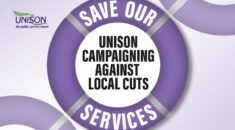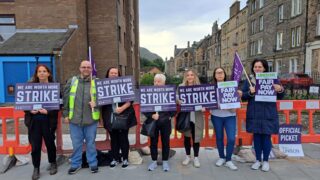Photo: Paul Dobraszczyk
The 18 months of the COVID-19 pandemic have been tough for local authorities, which have been caught in a financial vice.
On one side, they’ve lost what would normally be assured income, whether from council taxes and business rates, car parking charges or tourism; on the other, managing the pandemic – giving both financial and practical assistance to local people, the cost of adapting services so they can function under lockdown conditions, and providing additional services – has added enormously to their costs.
It’s not surprising, then, that the majority of councils around the country are reporting astronomical funding gaps – last year, this current year, and projecting years into the future. The consequences – for services, jobs and the physical environment of the communities these councils represent – is unthinkable.
In July this year the BBC reported that local authorities are predicting a £3billion shortfall in their budgets as they emerge from the pandemic.
Analysis of 170 upper-tier and single-tier councils in the UK, by the BBC Shared Data Unit, found that:
- UK local authorities plan to make at least £1.7bn worth of savings in the current financial year (2021-22), while also using more than £500m worth of reserves to balance the books;
- A quarter of those savings – some £434m – will be made in adult social care;
- Despite making the cuts, these councils predict a £3bn shortfall in their budgets by 2023/24;
- Nearly 60% of councils in England have raised council tax by the new statutory maximum of 4.99% to compensate for losses, a rise of about £100 on a yearly Band D bill in many areas.
In October 2020, the Local Government Association said that an extra £10billion was needed, every year, to help councils plug their funding gaps and improve their services – including £1.9 billion for homelessness alone.
And a report by the public accounts committee of MPs in January warned that many local authorities were taking on “excessive and risky debt” and that “the financial sustainability of some local authorities presents a significant risk to government.”
Whereas the ‘headline’ message in much mainstream media is that the financial crisis is a new phenomenon, purely pandemic related, this is far from the truth. What coronavirus has done is flush to the surface the virus afflicting local government, with Labour councils historically hit the hardest.
For UNISON’s members and activists, who for years have been struggling with frozen pay, job losses and reduced service budgets, this was a crisis long before COVID-19.
UNISON’s deputy head of local government, Mike Short, says: “Local authority finances are in a dire mess. This hasn’t happened overnight – a decade of austerity took away £16 billion in government funding for councils. But COVID made things far, far worse and has led to the situation we’re seeing now.
“Local authorities have stepped up to the plate during the pandemic, showing the wider public what we knew all along – that the services they provide are indispensable.
“It’s local government workers who made sure our communities were safe, educated our children, and looked after the most vulnerable.
“But the current position isn’t sustainable. Councils need emergency funding, to make sure local services can be retained. The funding gap they face needs to be closed right now. And we need more than that.
“The government needs to ensure a long-term financial settlement for local authorities – giving them the funding they need to provide local services, the stability they need to plan for the future, and the knowledge that they will be able to provide services in line with local needs.”
In speaking to a handful of councils – in Scotland, Wales, the East Midlands, the North and South East, UNISON has discovered different local experiences, but common problems – and one chief cause of everyone’s ills: the declining funding from central government.
Activists also agree that while making cuts that help neither their workers nor their communities, council leaders are caught between a rock and a hard place. They really have nowhere to go, nothing else to do.
Nottingham City Council
Labour
- Estimated funding gap 2021-24: £85.5m
- Around 500 jobs lost in past year across all services
- Youth services ‘decimated’ – adult social care is next
- Council narrowly avoids bankruptcy
Folly, poor funding and the pandemic is the triple whammy that has undone Nottingham, where the city council’s bold, even idealistic attempts to create income failed so spectacularly that it only just avoided bankruptcy.
The chief culprit was Robin Hood Energy, the council-run company set up to provide cheap energy to low-income households, which ended up losing the council £38m – alongside the millions chipped away from its budget by COVID. The company was closed down this year, with the loss of 230 jobs.
As a result of the council’s perceived financial mismanagement and poor governance, local government minister Robert Jenrick sent in Max Caller – the man who declared Northamptonshire County Council bankrupt in 2018 – to do an inspection. The result is that the authority is now overseen by an improvement board, closely scrutinising its every move.
The council’s way out of the immediate hole, earlier this year, involved a £10m grant from the government to cover COVID-related costs and a £20m capitalisation directive (permission from government to borrow in order to fund revenue costs). It’s also committed itself to a recovery and improvement plan that will change the way services are delivered – which spells more cuts.
Even so, council records predict deficits totalling £47.5m between 2022-24.

Photo: Smashman
UNISON branch secretary Christina Sanna puts the current crisis in context – one in which the council saw its revenue support grant from Westminster cut by £101m in seven years (2013 to 2021). “That’s an 80% reduction. And in the last 10 years, the council has made cuts of about £272m in its overall budget, with effects on both jobs and services.”
Alongside the Robin Hood jobs, the past year alone has seen two rounds of redundancies accounting for the loss of another 200+ jobs across the council’s services.
“Their idea is that they cut about 10% of the pay bill by the end of this year,” says Christina. “They say they’ve achieved 5%, so they’re looking for a further 5%. I argue that with the [latest] redundancies they’ve already, effectively, cut about 10% of their workforce. But obviously that’s not the same as cutting 10% of the pay bill, so there will be more redundancies. They’re absolutely clear about that.”
In the meantime, Christina and her branch colleagues are battling a problem that is becoming endemic for public services workers. “We’ve been having debates with the council officers and elected members, saying that they can’t keep cutting jobs and not reduce the workload. What we’re seeing now is a lot of people under a great deal of strain.”
Of the branch’s 5,000 members, around 3,000 work directly for the council, with others providing outsourced services. Their morale is “very, very low” she says. “Members are absolutely scared.”
Christina is equally concerned about the future of services, particularly ones offered to those most in need. Youth services have already been “absolutely decimated” she says. Others under threat include a leisure centre in one of the most disadvantaged inner city areas, and adult social care – including funding that supports adults with drug and alcohol dependency, mental health issues and learning disabilities, as well as a homelessness charity.
“I’m concerned that services will continue to be cut and the most vulnerable, disadvantaged communities will be the ones that suffer the greatest, those often without a voice,” she says. “And once those services are cut, they will never come back again.”
The branch has persuaded the authority to reverse some proposals, including disbanding the missing children’s team (“they were going to take it away from qualified social workers and fob it off onto youth workers”) and introducing contactless charging for toilets in the city centre. “We said, ‘Where are homeless people going to go when they need to use the toilet and have a wash? What about elderly people?’”
It’s also encouraging the council to agree a proper framework for hybrid working, to include health and safety issues, provision of equipment and to cover the thorny issue of voluntary versus mandatory.
Because, says Christina, the life of a union branch continues. “The be all and end all of our existence is to protect jobs and services, and to support members in the workplace. That’s what we will continue to do. And we’re trying to show our members the value of trade unionism.”
Leeds City Council
Labour
- Estimated funding gap 2021-24: £114.9m
- 900 staff made redundant since October
- Council looking to make savings by selling off offices
- Morale is very low – no job security
In the past nine months, 900 staff have left Leeds City Council as a result of redundancies. Unfortunately, this is nothing new.
“We’ve had redundancy notices in place since at least 2010,” says UNISON branch secretary Martyn Walker. “The membership has lived under constant threat of redundancy for over 10 years.”
The newest wave of job losses comes on the back of the dismal fact that, in September last year, the council identified an estimated budget gap of £163m for the period from 2020 to 2024.
“These were all voluntary. Leeds have generally managed to avoid mass compulsory redundancies,” Martyn observes. Nevertheless, job losses are inevitably followed by increased workloads.
“One thing we’ve really pushed with the employer is that when they propose staff reductions, they clearly lay out what work the remaining staff will be doing. Because what usually happens is that when you take one cleaner out of a team of three, the two remaining cleaners have to do 50% more work.”
Now, proposals to the council’s cabinet could mean working patterns and hours are moved around to avoid paying enhancements, Martyn says. “No more unsociable hours, weekend work or out of hours working. This means members are left with less pay because they’re no longer working these better-paid hours.
“A lot of these people working part-time, unsociable hours are women,” he adds. “They tell us, ‘I might as well go to work for a supermarket – you can get £12-14 an hour at Aldi’.
“Our stewards tell me how much all this has affected morale. Nothing feels secure anymore.”

Photo: Derek Dye
Reducing staffing costs isn’t the only way Leeds has tackled its budget gaps over the pandemic. “Even with the redundancies, the council were forced to put up things like funeral costs and the red pull alarms for the elderly, says Martyn. “They introduced fees for tipping certain types of rubbish and, guess what, fly-tipping massively increased.”
And while some services have become less accessible, others vanish entirely.
“I know of a couple of old people’s homes and a resource centre for disabled people that are closing because the buildings are no longer viable in terms of cost to repair. So instead of fixing the building, the services get closed down.
“A lot of the services have been automated. Rather than speaking to an individual, it’s all dealt with on the phone. All of these things make it that bit more difficult for vulnerable people to access services.
“The next thing could be museums, attractions, sports centres. They’ll have to put prices up and it will create an even bigger divide between rich and poor.”
Redundancies, cuts to services and money drawn from reserves, combined with some COVID-related funding from central government got the council to the point of balancing the budget for 2021/22. But it’s now predicting that it will need to make £100m more savings over the next two financial years to make ends meet.
Martyn concludes: “Everything gets tied up and blamed on the pandemic, but this funding issue was always going to happen, whether we had a pandemic or not. Leeds has shuffled deck chairs for 10 years and there’s no room to do that anymore. Yes, more services will vanish, and more jobs will be lost.
“Central government need to invest quickly in local authorities to prevent an irreversible decline in quality local service provision.”
North Lanarkshire Council
Labour minority
- Estimated funding gap 2021-24: £56.9m
- 5,000 jobs lost in 10 years – 20% of the workforce
- School staffing in chaos
- Council spending strongly dictated by Scottish government
North Lanarkshire Council covers an area that frequently features in lists of the most deprived areas in Scotland. Child poverty and under-employment are major issues. If ever an authority needed more money, not less, it might be this one.
Instead, North Lanarkshire is sitting on the precipice, with a projected £57m funding gap over the next three years. Marie Quigley, UNISON’s council branch secretary, says that 5,000 jobs have already been lost over the past decade – 20% of the workforce. And, after a pause in restructuring during the pandemic, partly enabled by COVID grants, she expects the cuts to resume.
Marie squarely cites “the continued under-funding of local government by the Scottish government” as the root cause of the council’s problems.
For one thing, the proportion of Holyrood’s public expenditure spend that goes to local government (as opposed to, say, health) is going down, she says. This is then compounded by the SNP’s policy of ring-fencing areas for council spending – basically dictating how the money it gives is spent.
“This has been the issue we’ve been trying to tackle over the last few years. Something like 60% of the current funding settlement to the council, for this year, is for ring-fenced projects, things that were SNP manifesto promises basically, like teacher numbers, so everything else gets a disproportionate cut. Things like street cleaning, gardening, youth work, adult education, which obviously sticks in the throat of the council’s Labour administration.
“In schools there’s a formula for how many teachers you must have, and if an authority goes below that staffing level it will be penalised. But there’s no extra money for that. That means if there are budget cuts to be borne by the education department, it comes from the single status jobs, it comes from our membership – clericals, special needs assistants, classroom assistants. Those roles have all been decimated in the last 10 years.”

Photo: Chiraljon
Marie says that the union broadly agrees with the council’s key priorities, which includes much-needed economic regeneration of the area. She also commends councillors for returning leisure and culture services in-house, with members TUPE’d back into the fold, and for supporting the union’s pay claim in Scotland.
However, as an employer, there are issues. “There’s a lot of impact on our members from things that they’re currently doing, like the digitalisation of everything that moves and replacing people with algorithms.” And of the ambitious regeneration plan, she says, “is all about creating jobs, but not necessarily within the council.”
And then of course there’s a decade’s worth of cuts, often made piecemeal but with a cumulative effect.
Marie notes that since 2018 there have been reductions in the numbers of school clerical officers, janitors and cleaners, in environmental health and fair trading officers, community learning and development workers and many more. Community centres and all of the council’s residential care homes have been closed.
One, heart-breaking move during the pandemic was the closure of the Outdoor Education Centre, in the Scottish Highlands, where every child in their last year of primary school was entitled to spend a week of outdoor pursuits; all the staff were made redundant, the building demolished and the land sold.
With plans for major restructuring back underway, current areas of concern for the branch include the replacement of classroom assistants with a new post, the learning assistant, which Marie describes as “providing support to special needs on the cheap.”
There’s a frequent narrative in public services, that everything is managed better in Scotland than it is in England, aided by a sympathetic Scottish government. Marie begs to differ.
“It’s certainly how the Scottish government like to spin it. And I do get a sense, especially speaking to colleagues from local authorities in England, that things are worse there. But our worry is that we’re just two or three years behind what’s happening in England. We can see a lot of our local authorities going in the same direction as they have in England – selling off their family jewels.”
Morale, she says, “is shocking, it’s the worst I’ve ever seen it. There’s no sense of permanency any more. It’s like Hogwarts staircases here – everything just moves. Restructure and lose jobs, restructure and lose managers, restructure and get that extra bit of funding.
“It’s just meant there aren’t enough people on the ground, they can’t recruit enough folk, everybody is just stressed to the max. It doesn’t feel like a job for life anymore.”
Eastbourne Borough Council
Liberal Democrat
- Estimated funding gap 2021-24: £9.7m
- Lost 60% of tourist income due to COVID-19
- Voluntary redundancies on the cards
- Eastbourne as a town could be changed forever
Even before the pandemic, UNISON was concerned about the financial well-being of local authorities on the south coast, places that are pretty and welcoming for tourists and visitors, but have their fair share of social issues.
“Those coastal councils have been in some sort of financial mire for quite some time,” says UNISON South East regional political officer Ryan Slaughter. “A place like Eastbourne relies heavily on the revenue from tourism, conferencing, hotels, all that kind of stuff. And if that revenue is cut, you get into serious issues.
“So COVID has had a massive impact, as you can imagine. They’ve lost a huge amount in terms of that revenue. And it’s not one bad year, this could set a council back for a long time.”
Eastbourne is the larger partner in a service level agreement with nearby Lewes District Council, the two operating services as one entity, while democratically and financially separate. It’s Eastbourne that is suffering the biggest financial pressures.
In fact, the council reported that it had lost 60% of its income during the pandemic, predicting worst case funding gaps of £6.8m for 2020/21 and £6m for 2021/22.
The government has allowed a capitalisation arrangement to cover some of the deficit. It’s believed the council has also received some assistance from the Culture Recovery Fund.
Ryan says both councils introduced piecemeal voluntary redundancies early in 2020, but this summer are embarking on consultations for more large-scale changes, in areas including waste, environment, housing, revenue and finance.
“I expect rationalisation, and voluntary redundancy will definitely be on the table. They’re going through a phase, I think, of ‘We’ll cut it out as much as possible’, to try to get this deficit down.
“In terms of services, they are changing. They are adjusting bulk waste collections, they’re going to charge more for garden waste collections, they are considering reductions of street cleaning and grounds maintenance, including parks and open spaces, and reducing the maintenance of the [seafront] parades. Public toilets would only be open during peak times, so that there doesn’t need to be a toilet attendant.”

Photo: Bigstock
While the Lewes and Eastbourne Councils branch is relatively small, with around 250 members, the impact could be significant.
“The position is quite simple: the councils have a plan to get out of the situation, and that’s at the detriment of UNISON members, in terms of their job security, and obviously to the local people.
“The reality is that councils have no choice. It’s a rock and a hard place for everybody – whether it’s Eastbourne or anywhere else. Until the political position changes, everybody’s going to have to make ends meet. The only solution is to get central government to fund councils at appropriate levels to be able to carry out the services that they need to do.”
Ryan also has an eye on the long-term effect of service cuts on Eastbourne itself.
“This raises the question, what kind of Eastbourne do you want? Do you want an Eastbourne that effectively has rubbish and litter everywhere and you can’t go to the toilet when you go to the beach? That’s the reality.
“At the moment, it’s a really nice, lovely clean town. Well, these cuts will change that.”
Caerphilly County Borough Council
Labour
- Balanced its 2021/22 budget after major contributions from Welsh government
- Estimated funding gap to 2024: £9.8m
- Lost over 1,500 staff through austerity
- Workloads sky-rocketing
The financial situation appears to be healthier in Wales than in the rest of the UK. Over the last 18 months, councils have been insulated from the devastating financial impact of COVID-19 by significant extra funding from the Welsh government.
The hardship fund allowed councils to make claims for whatever extra expenses and losses it incurred through COVID. For example, Caerphilly Council claimed close to £10m between March and December 2020.
Lianne Dallimore, Caerphilly branch secretary, says: “Over the pandemic it has been a measured, sensible approach from the Welsh government. Slow and steady.”
As well as shielding council finances, Lianne praises government policies such as enhanced sick pay schemes for social care workers, giving them full pay while they isolate, to help curtail the spread of the virus.
“In Wales we have what’s called the ‘social partnership’ which means we have trade unions actively engaged in policy discussions with ministers. It has certainly produced a better response to COVID than other parts of the country.”
The government’s commitment to doing what is necessary has been matched by the council workforce, Lianne continues. “Members have been protected from job losses and redundancies, but huge flexibility has been expected from them in their jobs – some people have been moved to a completely different job.”
For example, many day centres were closed over the pandemic and all of the workers redeployed into residential care, a completely different client group and with completely different expectations.

Photo: Bigstock
For all the Welsh government’s good work in funding councils over COVID, there are grave concerns about the continuity of the funding – an issue which begins with the government in Westminster.
“Wales has been underfunded by the Barnett formula for years,” says Lianne. “The chunk of funding that comes to us needs to be badly looked at. Councils had enough funding to balance the budget in 2021/22, but who knows how long that situation will last? Local authorities have already made all the savings they could possibly make, but austerity is back on the cards and it could be that COVID is the default excuse from now on.”
Welsh council finances were hit just as hard as their English and Scottish counterparts over austerity. Caerphilly was forced to make £106m of savings in the last 13 years, and over that time the council’s workforce fell from around 10,000 to just over 8,300, causing workloads to skyrocket.
“Caerphilly has always had a no redundancies policy and has always managed with vacancy management, but there comes a point where it’s no longer sustainable with workloads. A four-person department cut down to two can’t manage another loss.”
Over the next four years, Caerphilly council predicts that it will need to find another £21.1m worth of savings, but Lianne highlights how malleable this figure is: “Even a 2% increase in funding would mean Caerphilly only needs to find £9m, but without any increase at all, the figure jumps to £32m.”
She concludes: “Welsh councils have had the funding that they’ve needed this year, but they need more investment to help with the COVID rebuild, not less.”
It’s not all lost
So, there we have it. It’s austerity, it’s the pandemic, and it’s all coming to a head.
It’s a depressing tale and an uncertain future. It matters because what affects local government affects all of us. Our communities are run by local government. The services we all rely on and use every day of our lives are under threat. And hundreds of thousands of low-paid women are paying the hardest price: local government workers are not well paid – 16% don’t even earn £10 an hour and three quarters of the workforce are women.
But things can change. And you can help. Visit the campaign page to find out how bad cuts are in your area, watch our new campaign film, write to your MP and more.







What is freightening is that essential local authority services are having theig income cut year after year. There has been no public discussion about the substantial cuts to locally provided services services, and central government has not even seen the need to justify these savings. This is not democracratic, it is denying people choices about abolishing provision that affect their safety and quality of life while the money saved is showered on richest communities.